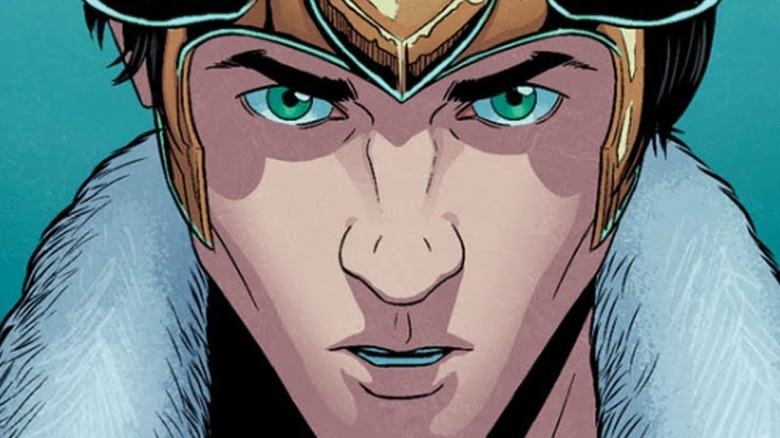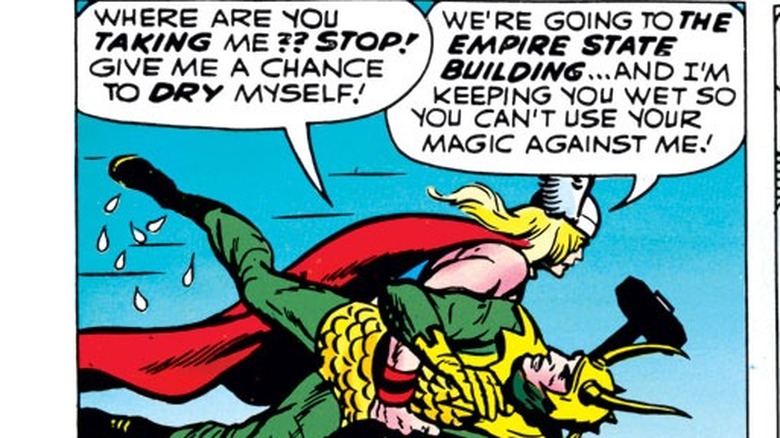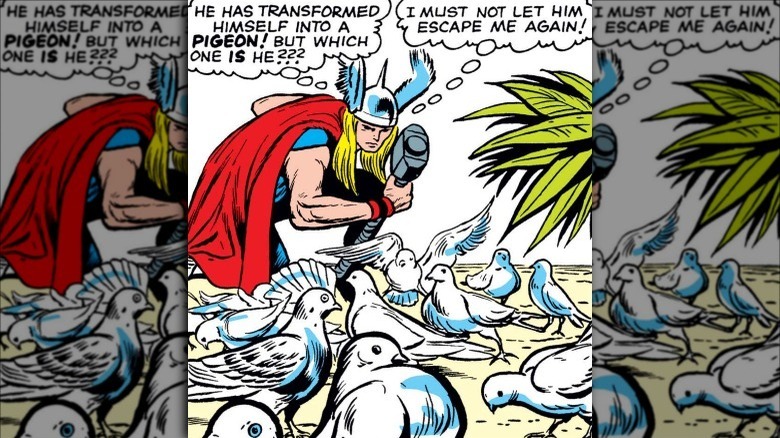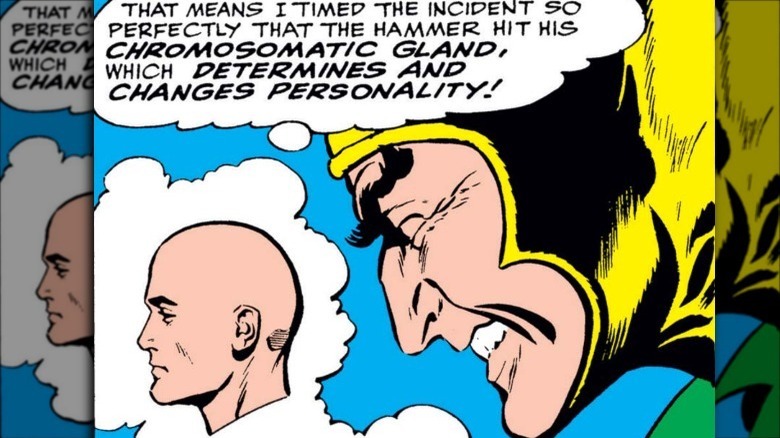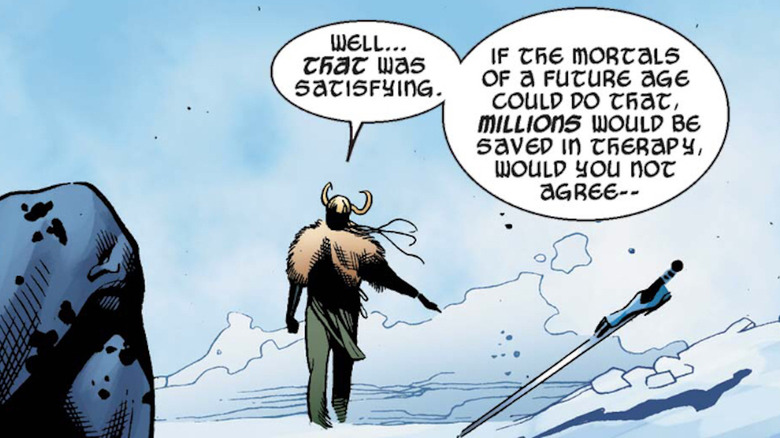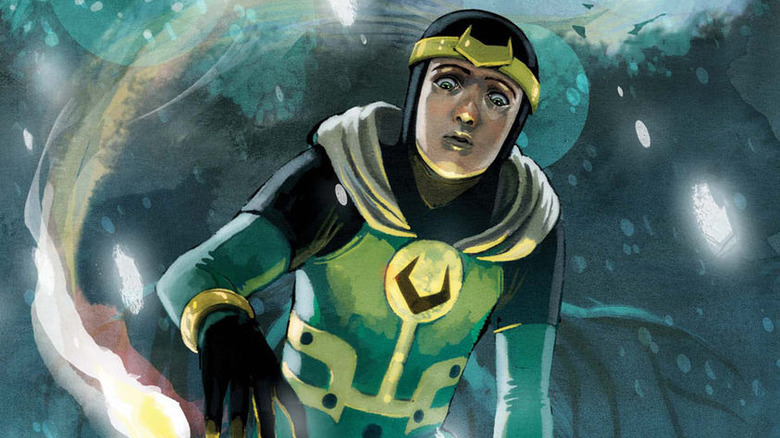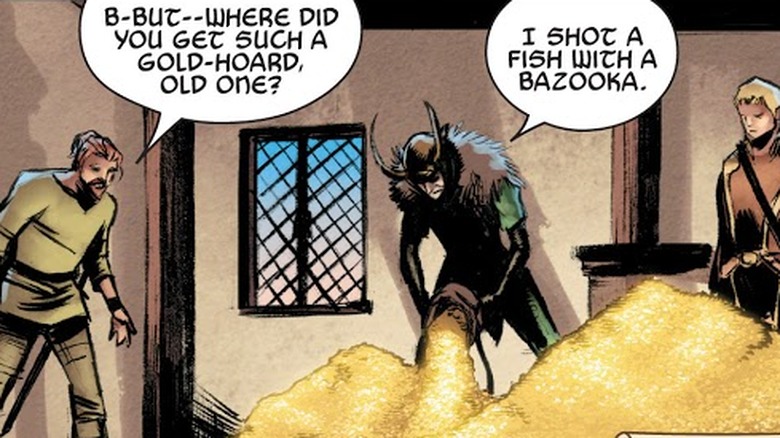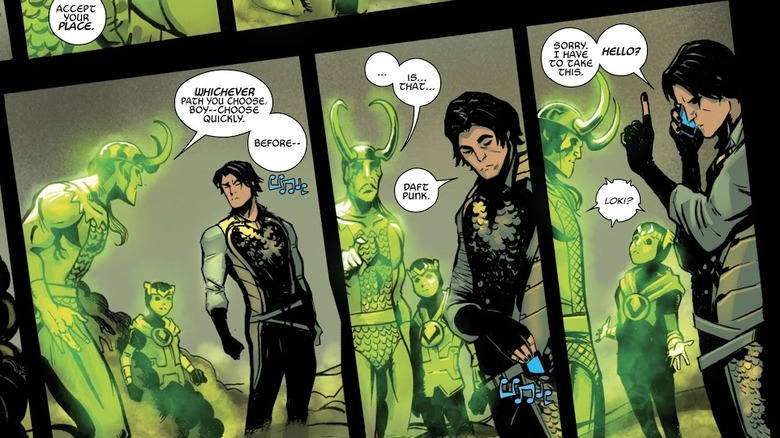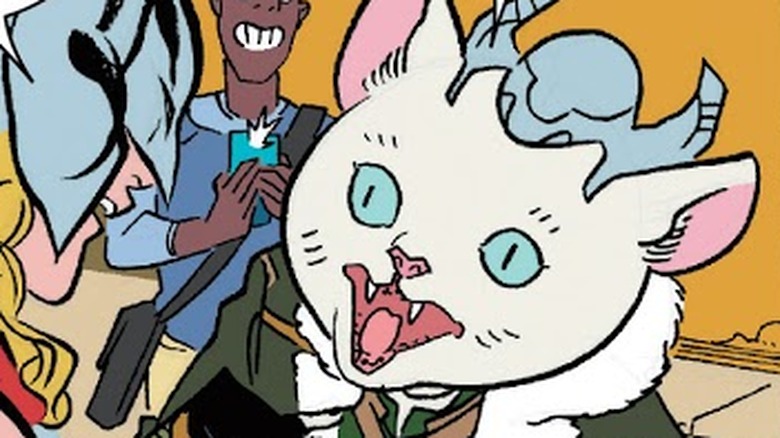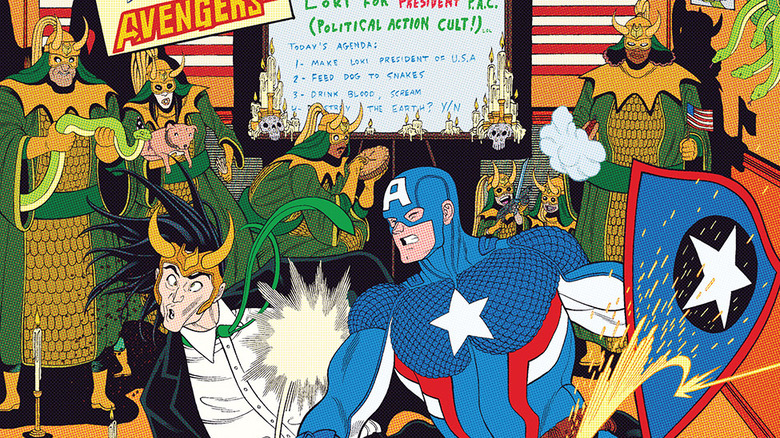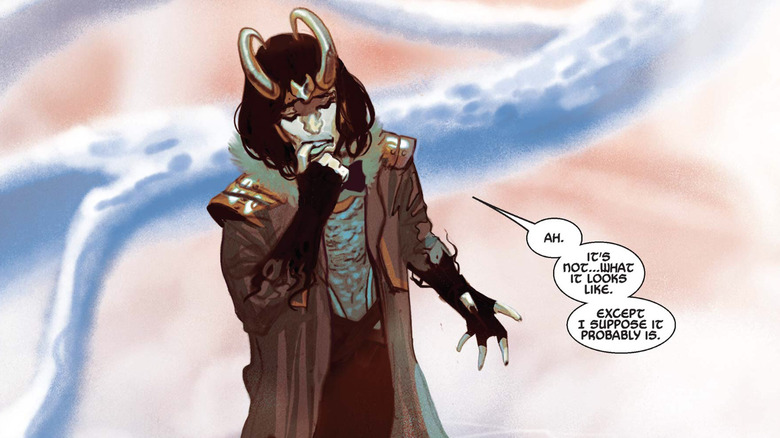The Weirdest Loki Stories Of All Time
MCU fans know that Loki often finds himself in some pretty bizarre scenarios. Over the course of the franchise, the trickster god has dealt with evil elves in "Thor: The Dark World," time travel and cosmic bureaucrats in Disney+'s "Loki," and a bloodthirsty but fabulous Jeff Goldblum in "Thor: Ragnarok." But as wild as his on-screen adventures get, those are hardly the weirdest adventures Loki's been involved with over the years.
And with a history that goes back to Stan Lee and Jack Kirby's first "Thor" comics in the early '60s, Loki has had more of those years than almost every other Marvel hero or villain. So we've searched through the history of Asgard's least favored son to see just how strange his adventures could get. From his first fights with Thor to his journeys back and forth through time, space, life, and death, here are some of the weirdest Loki stories ever told.
Loki got beaten by water in his first appearance
The Marvel Universe is such a cultural institution now that it's easy to forget it all started with Stan Lee and Jack Kirby pretty much just making it up as they went along. That's certainly true for Loki's first appearance in "Journey into Mystery" #85. Loki's first impression leaves a little to be desired since he can't think of any more serious mischief than reversing some random New Yorkers' colors. Stranger still, Thor restores them to normal because, as he explains out loud, "If I rotate my hammer fast enough, it will emit anti-matter particles!" That science is already questionable enough, but then Thor blows those particles at Loki's victims, which somehow restores them to normal instead of annihilating them.
With that done, Thor turns his attention to Loki, who keeps escaping — first in a flock of pigeons (pigeons will be a recurring theme here) and then by bringing the Mobilgas Pegasus logo to life. Thor knocks him off the creature's back with a length of pipe, sending him into the Hudson. Then Thor explains, "According to legend, Loki's magic powers are useless in water!" That doesn't sound like any legends we've been able to find. So it's probably for the best that Loki's water weakness doesn't show up in future comics either. They say you can tell a hero by the quality of their villains, and it doesn't reflect well on Thor to have an archnemesis who could be beaten by a garden hose.
Thor tricked the trickster god with a mannequin and a bag of peanuts
In "Journey Into Mystery" #88, Loki steals Mjolnir, the hammer that allows mortal Doctor Donald Blake to turn into Thor. (At least until Don was written out.) Worse still, the trickster puts an impenetrable forcefield around the weapon to keep Blake from changing back.
With his enemy out of the way, Loki is free to do what he wants with the people of Earth, and what he wants is a lot more whimsical than you'd expect from an ancient evil deity, like turning buildings into candy and cars into ice cream. When the military tries to stop him, Loki gives their guns little wings and watches them fly away. But the next day, Loki hears that Thor has returned. He rushes out to make sure the hammer's still where he left it and finds Thor waiting for him, hammer and all.
Loki lifts the force field to make sure Mjolnir is still there. It is ... but not for long. That's when Blake rushes in and grabs the hammer, changing into the God of Thunder. Adding insult to injury, Loki realizes that the first Thor he saw waiting for him in the park was just a plastic dummy. It only gets more humiliating after that, when Loki tries to hide in a flock of pigeons and Thor immediately finds him by tossing a bag of peanuts at them and watching for the one who has "more important things on his mind."
Loki clobbered Thor with his own hammer to change his personality
Writer Robert Bernstein and artist Joe Sinnott adapted one of Stan Lee's strangest plots for "Journey Into Mystery" #94. For whatever reason, the US military has decided to launch a nuclear missile into space. Your tax dollars at work! This very bad idea gets even worse when they lose control over the missile and call in Thor to destroy it before it can return to Earth.
It's all Loki's plan, of course, using his "remote control magic." Thor tosses his hammer at the missile, and while it's on its way back to him, Loki distracts him with an illusory dragon long enough for Mjolnir to whang its master on the back of the head. According to Loki, the hammer hit Thor square in the "chromosomatic gland, which determines and changes personality," which it might ... if any such gland existed. Take out the pseudoscience, and you've got an evil scheme straight out of "The Flintstones."
The newly evil Thor's rampage is just as cartoony, as he destroys various world landmarks, including, of course, tipping over the Leaning Tower of Pisa. Loki pitches in too, "awakening prehistoric behemoths in museums." Apparently, Mr. Bernstein was under the impression that museums kept whole dinosaurs lying around, with the skin and everything. Eventually, Odin and the other gods restore everything to normal by dropping Loki down a trapdoor and dropping the hammer in after him. Even "The Flintstones" folks might have thought that was too silly.
The God of Mischief went back in time to kill his own dad
When J. Michael Straczynski and Olivier Coipel brought the cast of "Thor" back from Asgard's destruction in the book's 2007 relaunch, Loki took advantage of his new lease on life to convince his brothers he'd turned over a new leaf. Of course, it's all just part of an intricate evil scheme. In #12, we see Loki continue to lay the groundwork for his tricksy plot, and it goes back further than you might have thought possible. With some help from Hela, the Goddess of Death, Loki returns to the distant past for some devious doings.
First, he traps Thor's grandfather, Bor, in the snow of the Frost Giant kingdom, with plans to bring him back later. Bor's ghost then haunts his son, Odin, threatening to harass him forever unless he adopts the child of the next man he kills. Of course, "Bor" is just Loki in disguise, and the boy that Odin will adopt is Loki himself. The adult Loki then meets his childhood self to engineer his own fate, and he even coaches li'l Loki to rush out and threaten to kill Odin for murdering his father. But as it turns out, Loki's abusive father, the giant king Laufey, isn't quite dead yet. But he will be soon enough since Loki takes advantage of this golden opportunity. Seeing his abusive father helpless, the God of Mischief picks up a discarded sword and starts hacking him to bits until there's not much left.
Loki was reborn as a kid and turned his past self into a bird
By the time of Marvel's 2010 "Siege" crossover, Loki's chaos god schtick wasn't working anymore. After all, how unpredictable could he be if he was always evil? But it was certainly unpredictable when, in #4, he sacrificed himself to save Asgard. But the "Sige: Loki" one-shot by Kieron Gillen and Jamie McKelvie suggests this was just one step in yet another master plan, with Loki wheeling and dealing to make sure the underworld goddess, Hela, can't claim him after his death. And in "Thor" #617, the God of Thunder discovers his brother has been reborn as a Parisian street urchin, paving the way for Gillen's run on "Journey into Mystery," beginning with #622.
Here, Kid Loki follows a series of convoluted clues to the ghost of his old self, who reveals his "death" was all part of a ploy to reinvent himself ... but then Kid Loki turns him into a magpie that he names Ikol. Kid Loki would continue with many strange adventures over the next couple of years. For example, he would fight and then side with a family of post-industrial gods in England. He would find new homes for a litter of hellhound puppies. And he would save the world from a gaggle of fear demons by tricking them into fighting over a crown made of his own fears. But in the end, the only one who can outsmart Loki is Loki, and in #645, Ikol reveals everything has been a ploy to erase Kid Loki from existence and take his place.
He once shot a fish with a bazooka
In Al Ewing and Lee Garbett's "Loki: Agent of Asgard," Marvel gave readers double the Loki, introducing the character of King Loki, a time-traveling trickster god from a future where he's become more evil than ever. Asgard's new rulers — Gaea, Freyja, and Idunn — bring him back to the present to serve as their advisor. But since they don't trust an older, evil-er Loki any more than any thinking person would, they keep him safely locked up.
At least, that's what he lets them think. In #3, King Loki simply walks off the page and into the past, where he meets a young Odin. The two of them kill, skin, and eat an otter, then meet Fafnir and Regin, who recognize the skin from their shapeshifting brother, Otr. Understandably, they hold Odin hostage until they receive enough gold to cover their brother's pelt.
Loki gets the cash from Andvari, a wizard who's transformed himself into a gigantic fish and made himself immune to all rods, nets, and magic. So Loki reaches in his bag and pulls out a rocket launcher because "Andvari could only guard against what he could think of. And wise as he was in the ways of magic ... he was somewhat unimaginative." With his dying breath, Andvari curses the gold to reveal the truth about whoever owns it ... which, of course, is fine with Loki as he's about to give it all away.
Loki gets cell service on other planes of existence
"Agent of Asgard" sees Loki in an immortal identity crisis, trying to make something better of himself despite all the cosmic forces (and, it's implied, readers) forcing him to play the same old role. Plus, he's struggling to atone for "the crime that can never be forgiven" — erasing Kid Loki. It all comes to a head in #10, when Loki confesses everything to Thor ... who exposes him in front of the rest of Asgard.
Then, with Loki in exile, King Loki muzzles, binds, and burns him, sending him into "Metaphorical Space," where, in #13, he's forced to confront his past selves, the old villain and the young hero. And they offer him a quandary straight out of "The Dark Knight" — he can die a hero, or he can live long enough to see himself become a villain.
In the middle of their lecturing, the other Lokis are interrupted by current Loki's cell phone. He explains he has "magic cell reception — from the thing in the place that one time." An editor's note points to #5, where Loki enchants his phone to communicate with his team while he coordinates an Asgardian prison break. Apparently, the spell was even more powerful than we'd been told.
The trickster turned into a cat-headed Thor
Ryan North and Erica Henderson's "The Unbeatable Squirrel Girl" is one of the zaniest comics to come out of Marvel in recent years, so it figures an appearance by Loki would lead to one of the God of Lies' zaniest adventures. Squirrel Girl needs his help in Vol. 1, #8 when she discovers the "Girl Squirrel" — who's been turning her friends against each other — is actually Ratatoskr, the Asgardian goddess of discord who nearly destroyed the Earth the last time she escaped. And, of course, it all turns out to be Loki's fault. ("What? I said, 'My bad!'")
The incident also introduces Loki to Squirrel Girl's roommate, Nancy Whitehead, and her "Cat Thor" comics. Loki loves her art so much that he turns himself into Cat Thor, and when his brother complains, he just makes his giant feline head even bigger and promises, "This is my new regular head forever now." After all, Loki may be an all-powerful deity, but he's also an annoying younger brother. This is the kind of silliness most writers would exile from canon immediately, but fortunately for us lunacy-lovers, Marvel's current creators enjoy it just as much they do. How else could you explain Russell Dauterman's decision to sneak Cat Thor-Lok into the army of alternate Lokis in 2015's "The Mighty Thor" #3?
That time Loki ran for president
Yeah, 2016 was already the weirdest election year in living memory, but it was even weirder in the Marvel Universe, with a literal god throwing his horny hat into the ring. In Christopher Hastings and Langdon Foss' "Vote Loki," the Asgardian's campaign kicks off when he rescues the two never-named presidential candidates from an attack by Hydra. Then, his pointed comments on the election have viewers pulling for him to win the presidency before he even officially starts running, all over the objections of Daily Bugle reporter Nisa Contreras, who barely survived one of Loki's battles with the Avengers as a girl.
She spends the rest of the series digging up dirt on the trickster god, but no matter what she finds — that Loki has a "Political Action Cult" sacrificing goats to rig the polls, that he interfered in the sovereign nation of Latveria, that he staged the Hydra attack and murdered the agents to shut them up — only makes him even more popular. In the end, it takes Loki himself to take Loki down. When his fanbase start asking him about his actual views, the whole movement falls apart. But this is Loki, after all, so maybe that was the plan the whole time, as the book ends with Loki letting one of the other candidates know he put them over the top by splitting the vote.
Loki finally got to kill Thor ... because Thor asked him to
Jason Aaron's epic seven-year run on "Thor" was as full of pure comic book wackiness as much as anything else he's written, which includes crazy stuff like god butchers, candy-shooting cowboy elves, and both lava- and space-sharks. So of course Loki would end up getting in on the act.
In 2018's "Thor," #1–4, Aaron and artist Mike del Mundo take Thor and Loki to Hel and back to fight in the War of the Realms. As soon as they arrive, they meet their brother, Balder, in a monster truck that the cast of "Mad Max" might call "a little much," and it just escalates from there. Loki loses out on driving duty to Thor's pet goat, and their other brother, Tyr, appears riding on the back of a dinosaur. But to defeat the armies of the flame kingdom Muspelheim, Thor needs Asgard's mightiest warriors, who, unfortunately, are all dead. To recruit them from Valhalla, Thor needs to die himself. Loki does the deed with a dagger to the chest in #3, and Thor returns with the greatest heroes of Asgardian history behind him in the following issue, successfully driving the flame warriors back from Hel.
